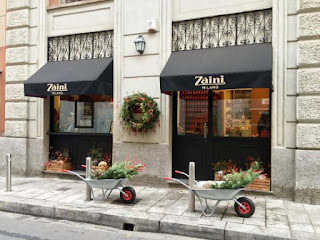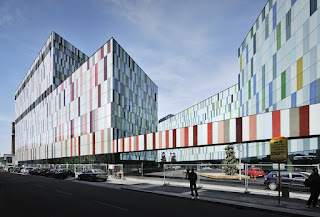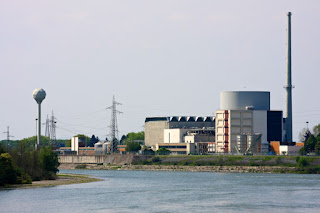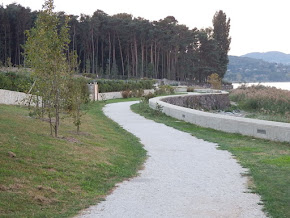First factory opened in Via Carlo de Cristoforis in Milan
 |
| The distinctive Zàini logo has become known in 80 countries around the world |
The plant, opened by Luigi Zàini, a young entrepreneur, in Via Carlo de Cristoforis, was advertised as a ‘Factory of Chocolate, Cocoa, Candies, Jams and Similar’.
Zàini, who had experience in the confectionery business as an importer of biscuits, jams and other sweet products from northern Europe, had noted the rapidly growing popularity of chocolate and thought the time was right to move on from his role as middleman and become a producer in his own right.
In Milan at the time there were around 15 chocolate factories, so competition was keen, but Luigi had a unique selling point in mind. His dream was to be able to satisfy any wish for something sweet, reportedly saying: “Everyone is different, so why aren’t we creating lots of different chocolates and sweets for each different person?”.
.jpg) |
| Luigi Zàini, in the centre of the front row, pictured with all the employees at his first factory |
And he put his entrepreneurial instincts to good use to make sure the public knew about Zàini’s rich dark chocolate bars. Years ahead of the football sticker craze launched by Giuseppe Panini in the 1960s, Luigi hit upon the idea of selling chocolate bars with free collectors’ cards featuring celebrity figures from the worlds of sport and entertainment, in particular footballers and silent movie stars.
In 1924, Luigi Zàini married Olga Torri, whose father owned a large grocery store in Milan. It was a second marriage for both following the loss of their first partners. The couple brought six children to the marriage from their previous relationships, including Luigi’s son Piero and daughter Rosetta, and had two of their own, Vittorio and Luisa.
Business continued to thrive and, in 1926, the company moved to a new factory in Via Carlo Imbonati in the Dergano district, about 2.5km (1.5 miles) from Via de Cristoforis. It remains the company’s headquarters today.
Sadly, Luigi Zàini died in 1938, struck down prematurely by serious illness. Olga, with whom Luigi shared an elegant house built within the courtyard of the factory premises, knew Luigi wanted the business to remain in the family after his death, and took the reins herself.
.jpg) |
| Olga Zàini, later to take over the business, pictured with son Vittorio in around 1930 |
World War Two presented new challenges. In order to protect the children, Olga relocated the family to Varese, a city some 50km (31 miles) away from Milan, midway between the great lakes of Como and Maggiore. She returned to Milan regularly to supervise production.
Situated in an industrial area of Milan close to major rail arteries into the city, the Zàini plant had the misfortune to be next to an anti-aircraft battery positioned to defend the area. Inevitably, heavy bombardments followed as Allied planes attacked the city and the factory suffered such enormous damage during a series of raids in 1943 that was effectively destroyed.
Yet Olga set about rebuilding it as soon as it was safe to do so, winning praise for putting much of the physical reconstruction work in the hands of the factory’s own employees to ensure they could continue to support their families.
Olga remained in charge of the business until the 1950s, when she took the bold step to rebrand Zàini’s traditional dark chocolate bar ‘Emilia’, after the family nanny who looked after her children while away in Varese, before handing over control to Vittorio and Piero.
 |
| The Zàini Milano chocolate shop in Via Carlo de Cristoforis, near the site of the original factory |
Since the 1990s, Luigi Zàini spa has been run by a third generation of the family - Vittorio’s son and daughter, Luigi and Antonella.
Among their initiatives, with a nod to their grandmother’s commitment to helping women, is Le Nuove Donne del Cacao, a new line of chocolate bars introduced to support a female entrepreneurship project aimed at achieving equal opportunities for women cocoa farmers in the Ivory Coast.
In 2013, to mark the 100th anniversary of the business, Luigi and Antonella opened the Zàini Milano cafe and chocolate shop, in Via de Cristoforis, the same street where their grandfather had opened his first factory.
The company today, now the sole large-scale chocolate manufacturer in Milan, has 200 employees and three production plants, located in Milan and the nearby town of Senago, with Zàini products on sale in 80 countries around the world.
 |
| The striking, colourful design of the Centro Maciachini in the Dergano district |
Dergano, where the Luigi Zàini brand is still based, is much changed from the industrial zone it was when the factory was bombed in World War Two. Where factories once stood, complexes such as the Centro Maciachini, built on the site formerly occupied by Carlo Erba pharmaceutical company, abandoned in the 1990s, which comprises among other things a commercial sector, a food park and the Teatro Bruno Munari. Dergano was once home to Armenia Films, built in 1917 and once seen as a rival to Rome’s Cinecittà. The entrance to the studios, where the great director Luchino Visconti shot his first film, still stands in Via Baldinucci. Once a rural village, the area again has the feel of a small community with a number of cafes and restaurants and independent shops.
.jpeg) |
| The ultra-modern Piazza Gae Aulenti is a feature of Milan's fashionable Porta Garibaldi district |
Just a 15-minute walk from the Milan city centre, Porta Garibaldi is popular amongst tourists and locals alike for its restaurants, bars and nightlife. Corso Como, a wide pedestrianised thoroughfare leading directly to the neoclassical Porta Garibaldi arch, a Doric-style gateway built in the 19th century, has pavement cafes and fashion boutiques. The area is also famous for its avant-garde architecture and the impressive Piazza Gae Aulenti, a futuristic square designed by the Argentinian architect César Pelli, who also designed the square’s 231-metre (758ft) Unicredit Tower, which is Italy’s tallest building in the country.
Also on this day:
1866: The birth of composer Francesco Cilea
1909: The birth of soprano Licia Albanese
1941: The birth of Italian president Sergio Mattarella
1922: The birth of screenwriter and director Damiano Damiani


.jpg)
